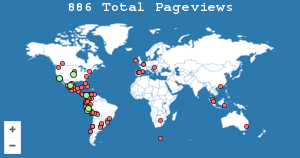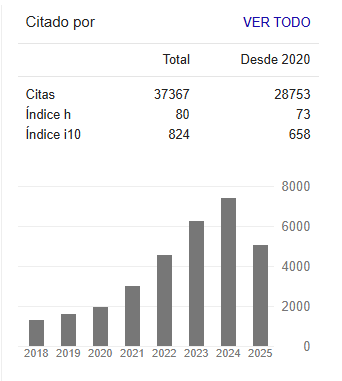Capital intelectual para el desempeño organizacional y la competitividad
Resumen
El capital intelectual ha sido estudiado en los últimos años para entender su influencia en el desempeño organizacional y en la ventaja competitiva. La investigación se desarrolló en un astillero peruano. El objetivo fue analizar la relación entre el capital intelectual y el desempeño organizacional. El astillero opera hace 75 años, tiene más de 1,500 trabajadores y tiene presencia nacional e internacional. La metodología fue cuantitativa, correlacional. La muestra estuvo constituida por 92 encuestados y se emplearon cuestionarios con escala tipo Likert. Los resultados evidenciaron la relación entre el capital intelectual y el desempeño organizacional; así como la relación entre los componentes del capital intelectual y con el desempeño organizacional. Se concluye sobre la necesidad que el astillero desarrolle, como parte de su estrategia, una gestión enfocada en el desarrollo y fortalecimiento de los intangibles como una condición necesaria para mantenerse competitivo y lograr un desempeño superior.
Citas
Americaeconomia.com. (2013, julio). Colombia aspira a liderar la innovación del sector naval en América Latina al 2022. Americaeconomia.com. https://www.americaeconomia.com/politica-sociedad/politica/colombia-aspira-liderar-la-innovacion-del-sector-naval-en-america-latina-
Andreeva, T., y Garanina, T. (2016). Do All Elements of Intellectual Capital Matter for Organizational Performance? Evidence From Russian Context. Journal of Intellectual Capital, 17(2), 397-412. https://ssrn.com/abstract=3489926
Bagozzi, R. P., & Yi, Y. (1988). On the evaluation of structural equation models. Journal of the academy of marketing science, 16(1), 74-94. https://doi.org/10.1007/BF02723327
Barkat, W., & Beh, L.-S. (2018). Impact of intellectual capital on organizational performance: Evidence from a developing country. Academy of Strategic Management Journal, 17(2), 1-8. https://doi.org/10.1016/j.sbspro.2015.11.085
Barney, J. B. (1991). Firm Resources and sustained Competitive Advantage. Economics Meets Sociology in Strategic Management, 17(1), 99-120.
Benzaquen, J. (2016). La Industria Naval en el Perú. Revista Estrategia Centrum, 42, 140-161.
Bontis, N. (1998). Intellectual Capital: An Exploratory Study that develops measures and models. Management Decision, 36(2), 63-76.
Bontis, N., Dragonetti, N. C., Jacobsen, K., & Roos, G. (1999). The knowledge Toolbox: A Review of the Tools Available to Measure and Manage Intangible Resources. European Management Journal, 17(4), 391-402. https://doi.org/10.1016/S0263-2373(99)00019-5
Bontis, N., Keow, W., & Richardson, S. (2000). Intellectual capital and business performance in Malaysian industries. Journal of intellectual capital, 1(1), 85-100.
Cabrita, M. do R., & Bontis, N. (2008). Intellectual Capital and Business Performance in the Portuguese Banking Industry. Int. Journal Technology Management, 43(1-3), 212-237. https://www.inderscienceonline.com/doi/abs/10.1504/IJTM.2008.019416
Collins, C. J., & Clark, K. D. (2003). Strategic human resource practices, top management team social networks, and firm performance: The role of human resource practices in creating organizational competitive advantage. Academy of management Journal, 46(6), 740-751.
COTECMAR. (2016). COTECMAR-pag Web. COTECMAR. http://www.cotecmar.com/
Drucker, P. F., & Nannetti, J. C. (1995). La Sociedad Post Capitalista. Norma. https://books.google.com.pe/books?id=1KiEQgAACAAJ
Dzenopoljac, V., Yaacoub, C., Elkanj, N., & Bontis, N. (2017). Impact of intellectual capital on corporate performance: Evidence from the Arab region. Journal of Intellectual Capital. https://doi.org/10.1108/JIC-01-2017-0014
Edvinsson, L., & Malone, M. (1997). Intellectual Capital: Realizing your Company´s true value by finding its hidden brain power (1° Ed). Harper Business.
Edvisson, L., & Malone M. (2000). El Capital Intelectual: Cómo Identificar y Calcular el Valor de Los Recursos Intangibles en su empresa. Norma.
Ekaningrum, Y. (2021). The influence of intellectual capital elements on company performance. The Journal of Asian Finance, Economics, and Business, 8(1), 257-269.
Gogan, L., Artene, A., Sarca, I., & Draghici, A. (2016). The Impact of Intellectual Capital on Organizational Performance. Procedia - Social and Behavioral Sciences, 194-202. https://doi.org/10.1016/j.sbspro.2016.05.106
Gómez-Valenzuela, V. (2016). Evidencias del efecto del capital intelectual en el desempeño de empresas de la República Dominicana. Ciencia y sociedad, 41(4), 823-868.
Guardamino, C. y Egoavil, J. V. (2021). Desempeño de las exportaciones en Sudamérica: ¿Los intangibles afectan el desempeño de las empresas en países en desarrollo como Perú? Rev. adm. empres., 61(2), e20190569. https://doi.org/10.1590/s0034-759020210205
Hair, J. F., Sarstedt, M., Pieper, T. M., & Ringle, C. M. (2012). The use of partial least squares structural equation modeling in strategic management research: A review of past practices and recommendations for future applications. Long range planning, 45(5-6), 320-340.
Hernandez Sampieri, R., Fernandez Collado, C., & Baptista Lucio, M. del P. (2014). Metodología de la Investigación (6ta ed.). Mc Graw Hill.
Hopkins, W. G. (1997). A new view of statistics. Will G. Hopkins.
Hornungová, J. (2014). Development of Concepts and Models of Performance Evaluation from the 19th Century to the Present. DANUBE: Law, Economics and Social Issues Review, 5(2). https://content.sciendo.com/view/journals/danb/5/2/article-p143.xml
Hulland, J. (1999). Use of partial least squares (PLS) in strategic management research: A review of four recent studies. Strategic management journal, 20(2), 195-204.
Iqbal, A., Latif, F., Marimon, F., Sahibzada, U. F., & Hussain, S. (2019). From knowledge management to organizational performance: Modelling the mediating role of innovation and intellectual capital in higher education. Journal of Enterprise Information Management.
Jacobo-Hernández, C. A., Leyva-Osuna, B. A., Daniel Ochoa, Y. J., & Mendoza Apodaca, M. del R. (2019). La influencia del capital intelectual en el desempeño organizacional en empresas turísticas de México. Revista interamericana de ambiente y turismo, 15(1), 72-81.
Khalique, M., Bontis, N., Shaari, J. A. N. B., Yaacob, M. R., & Ngah, R. (2018). Intellectual capital and organisational performance in Malaysian knowledge-intensive SMEs. International Journal of Learning and Intellectual Capital, 15(1), 20-36.
Khan, S. Z., Yang, Q., & Waheed, A. (2019). Investment in intangible resources and capabilities spurs sustainable competitive advantage and firm performance. Corporate Social Responsibility and Environmental Management, 26(2), 285-295.
Lopez-Nicolas, C., & Meroño-Cerdan, A. (2011). Strategic Knowledge Management, Innovation and Performance. International Journal of Information Management, 31(6), 502-509. https://doi.org/10.1016/j.ijinfomgt.2011.02.003
Maditinos, D., & Sevic, Z. (2010). Intellectual Capital and Business Performance: An Empirical Study for the Greek Listed Companies. European Research Studies Journal, XIII(3), 145-167.
Martinez Avila, M., y Fierro Moreno, E. (2018). Aplicación de la técnica PLS-SEM en la gestión del conocimiento: un enfoque técnico práctico. RIDE, 8(16), https://doi.org/10.23913/ride.v8i16.336
McGivern, M., & Tvorik, S. (1997). Determinants of Organizational Performance. Management Decision, 35(6).
Mention, A.-L., & Bontis, N. (2013). Intellectual Capital and Performance within the Banking sector of Luxembourg and Belgium. Journal of Intellctual Capital, 14(2). https://doi.org/10.1108/14691931311323896
Meritum. (2002). Proyecto Meritum—Directrices para la Gestión y Difusión de Información sobre Intangibles.
Mubarik, M. S., Naghavi, N., & Mahmood, R. T. (2019). Intellectual capital, competitive advantage and the ambidexterity liaison. Human Systems Management, 38(3), 267-277.
Nunnally, J. C. (1994). Psychometric theory 3E. Tata McGraw-Hill Education.
Obeidat, U., Obeidat, B., Alrowwad, A., Alshurideh, M., Masadeh, R., & Abuhashesh, M. (2021). The effect of intellectual capital on competitive advantage: The mediating role of innovation. Management Science Letters, 11(4), 1331-1344. http://www.growingscience.com/msl/Vol11/msl_2020_390.pdf
Peinado, E. (2016). Capital Intelectual e Desempenho Organizacional na Indústria Farmacêutica. Universidade Estadual do Oeste do Parana.
Pensore, E.T. (1959). The Theory of the Growth of the Firm. John Wiley.
Plataforma Digital Unica del Estado Peruano. (s.f.). Presidencia del Consejo de Ministros. Industria Naval del Per’u se ha convertido en referente en Latinoamérica. https://www.gob.pe/institucion/pcm/noticias/82338-industria-naval-del-peru-se-ha-convertido-en-referente-en-latinoamerica
Proaño, J. (2014). La Importancia Estratégica de las Reparaciones Navales, y su incidencia en la Economía y Finanzas del sector del Transporte Marítimo. Universidad de San Martín de Porres, Lima, Perú.
Reed, K., Lubatkin, M., & Srinivasan, N. (2006). Proposing and Testing an Intellectual Capital-Based View of the Firm. Journal of Management Studies, 43(4).
Salehi, M., Gouji, A. S., & Dashtbayaz, M. L. (2020). The effect of intellectual Capital on corporate performance. ABAC Journal, 40(4), 149-173. http://www.assumptionjournal.au.edu/index.php/abacjournal/article/view/3742
Sarwenda, B. (2020). Intellectual capital, business performance, and competitive advantage: An empirical study for the pharmaceutical companies. QUALI TY Access to Success, 103-106.
Sharabati, A.-A. A., Naji Jawad, S., & Bontis, N. (2010). Intellectual capital and business performance in the pharmaceutical sector of Jordan. Management decision, 48(1), 105-131.
Sharabati, A.-A. A., Nour, A.-N. I., & Shamari, N. S. (2013). The impact of intellectual capital on Jordanian telecommunication companies’ business performance. American Academic & Scholarly Research Journal, 5(3 special issue), 32.
Singh, S. K., Gupta, S., Busso, D., & Kamboj, S. (2021). Top management knowledge value, knowledge sharing practices, open innovation and organizational performance. Journal of Business Research, 128, 788-798.
Stewart, T. A., & Zadunaisky, D. (1998). La Nueva Riqueza de las Organizaciones: El Capital Intelectual. Granica. https://books.google.com.pe/books?id=QewAHzgWxfEC
Sveiby, K. E. (1997). The new organizational wealth: Managing & measuring knowledge-based assets. Berrett-Koehler Publishers.
Todericiu, R. (2021). The Impact of Intellectual Capital on the SMEs Performance: A Study of the Romanian Central Region SMEs. Studies in Business and Economics, 16(1), 198-209.
Usakli, A., & Kucukergin, K. G. (2018). Using partial least squares structural equation modeling in hospitality and tourism. International Journal of Contemporary Hospitality Management, 30(11), 3462-3512. https://doi.org/10.1108/IJCHM-11-2017-0753
Vara-Horna, A. (2010). ¿Cómo hacer una tesis en ciencias empresariales? (2da. ed.). Universidad san Martin de Porres.
Verma, T., & Dhar, S. (2016). The Impact of Intellectual Capital on Organizational Effectiveness: A Comparative Study of Public and Private Sectors in India. The IUP Journal of Knowledge Management, India, XIV(3), https://ssrn.com/abstract=2957477.
Wang, W.-K., Lu, W.-M., Kweh, Q. L., & Cheng, I.-T. (2014). Does intellectual capital matter? Assessing the performance of CPA firms based on additive efficiency decomposition DEA. Knowledge-Based Systems, 65, 38-49. https://doi.org/10.1016/j.knosys.2014.04.004
Wernerfelt, B. (1984). A Resource-Based View of the Firm. Strategic Management Journal, 5(2), 171-180.
Ying, Q., Hassan, H., & Ahmad, H. (2019). The role of a manager’s intangible capabilities in resource acquisition and sustainable competitive performance. Sustainability, 11(2), 527.

Esta obra está bajo licencia internacional Creative Commons Reconocimiento-NoComercial-CompartirIgual 4.0.








.png)






























